 The following are the slides and major talking points for Day Two at the Competency-Based Education Workshop.
The following are the slides and major talking points for Day Two at the Competency-Based Education Workshop.
Feel free to leave questions or suggested resources in comments.

The next 2 hours is for you. If you need to use your time for something specific to your district please do so.
However, we have designed 4 options for you based on where you are as an organization and who your team is today. These are all mapping exercises that will hopefully help you clarify next steps — as always make them work for you.
As always, self-organize with your facilitator, time keeper, note taker and story teller. Change up your roles! Be sure to create a map that we can put on the walls that others can take a peek at. And you can take home with you.

The concept map is for you if you are trying to figure out how all the things that you have in place fit into a personalized, competency-based system. Or how things might need to change. You’ll start by sketching out the cycle of learning and then all the pieces that are needed to support it.
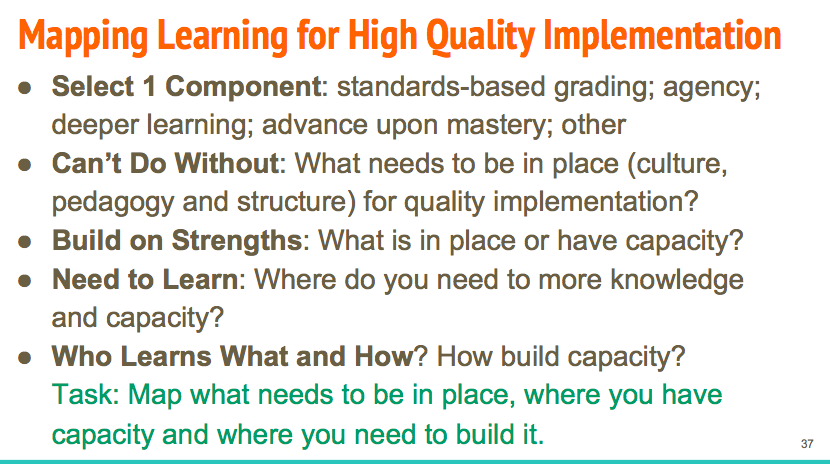
The learning map is for you if you want to start building up your capacity around some of the core components you hear about with CBE. These are some of the big changes and building up understanding and capacity can help. Rebecca Midles, one of my go-to people, once said that she would have schools focus on social emotional learning and growth mindset for several years if she could before putting anything else into place.

The mapping of systems change is if you are starting to think about implementation. You will be trying to identify the sequencing that would help you move forward. You’ll want to take time to think about quick wins or things that change the experience for students and teachers.
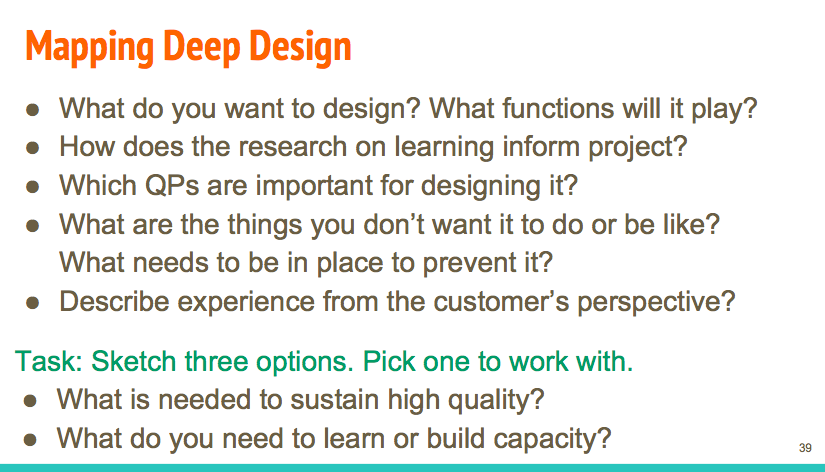
Finally, the deep design is for districts that want to focus on one practice or policy and thinking very deeply about what it would like and how you could implement it with quality. The trick here is to sketch out a couple of options — don’t jump too quickly to one design.



At CompetencyWorks we developed 16 quality principles based on the input of over 150 practitioners and researchers. The first cut emphasized structural changes and we got the feedback loud and clear that we needed to emphasize culture and pedagogy. Thus, think of it as a balanced three-legged chair. Each district was sent a copy of the book and you can also find all 16 principles on Learning Edge on the pre-reads and resources article.
See: Sturgis, C. & Casey K. (2018). Quality principles for competency-based education. Vienna, VA: iNACOL.
It’s difficult to process all of the quality principles at once. The best thing to do is focus in on a few at a time. You can create assessment tools to help you to look at your school using just a few. Or if you go to visit a school, you can create a tool to capture your thoughts about what you see using a few of them.
I selected four of the quality principles for our conversation as they are so important but also slip away as schools focus on structural changes and practice;

This feels like it should be a no-brainer but in fact it has huge implications especially for secondary school. The core ideas to pay attention to are 1) students are active learners. They are not going to learn that well just listening and taking notes. 2) Thinking and learning is hard work. We much prefer to remember or turn to prior knowledge than to learn new ideas. Thus, effort is required to learn because thinking is just so hard. 3) So the question is how do get students to maximize effort. Effort is dependent on the degree of motivation and self-regulation. So we need to think about how schools are designed to motivate students and to continue to help them to learn to self-regulate their learning.
One important aspect of research on learning is that it is developed within academic domains. They are essentially silos. It’s left up to educators to make sense of the findings and know how to use them well. This means that professional learning and inquiry becomes important when you shift your school to using the research on learning to guide you.
If you are taking neuroplasticity seriously, you can even think of teachers as brain changers…a phrase I learned from a book called Neuroteach. You can also put the knowledge about learning right into the hands of students — the more they know about the research on learning the more they can think about their own learning. Finally, it’s worth taking the time to think carefully about the research on learning and the implications for historically underserved students. I’ll touch on this in a minute.

We had a bit of debate while I was at CompetencyWorks about school culture. Some argued that a culture of high achievement should be the same for traditional schools or for more modern schools. That is true. But dig a bit deeper and there are aspects of school culture that continue to emphasize compliance and ranking. For high achieving students benefiting from the traditional system, there isn’t a problem But for anyone else, it starts to make school feel unsafe.
And safety is very, very important for learning. Thus, adults and students need to know their amygdala’s and when they are feeling scared. Because learning is going to slow down or even stop. The same goes for trust and the quality of the relationships — they influence how safe we feel in terms of taking risks and showing what we dont’ know. Which raises an important question — are there ways we can organize schools to strengthen the quality of the relationships between teachers and their students?
I highly recommend the book Culturally Responsive Teaching and the Brain by Zaretta Hammond as the go-to book to help embed cultural responsiveness not as a set of practices but as an overall culture of belonging.
Another area is thinking about what it means to institutionalize policies and practices around the growth mindset. If we really believe students can learn with the right conditions and supports, what would that look like? It means giving students extra flex time during the school day with skilled teachers to help them. It might mean students can always revise their work at any time during the year. It might mean continual coaching on self-regulation and metacognition to help students understand the link between their mindsets, behaviors and achievement.
Finally, for leaders it means thinking deeply about how your actions shape the culture and the environment. We know there are always two cultures in any organization. One is the espoused one. The formal one. The other is the one in action. The informal one. Leaders have to pay attention to both and try to bring them into alignment.
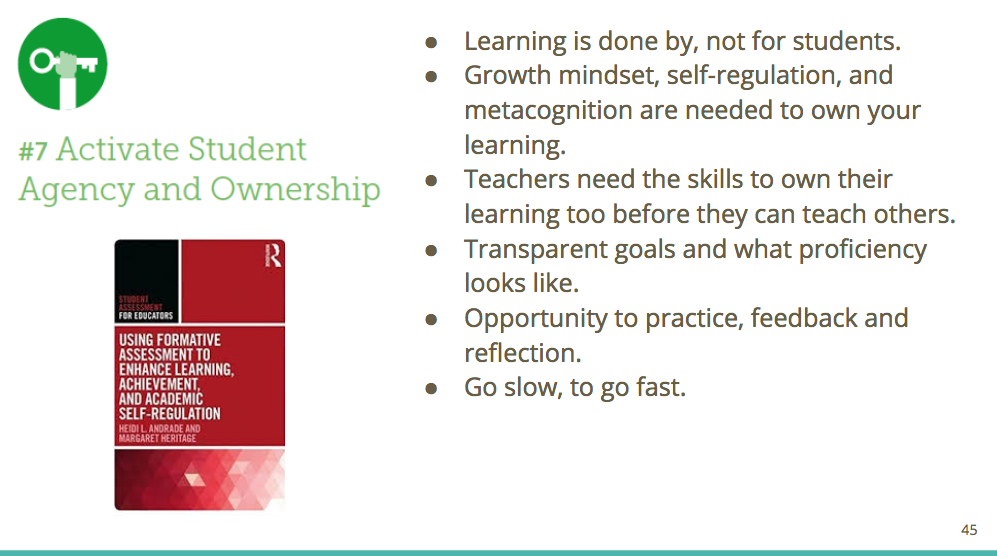
As I’ve already mentioned, the research tells us that learning is done by and not for students. There is no way to transmit knowledge from one person to the other. We each have to create meaning and knowledge for ourselves. Which means we all need the skills and mindsets to do it. This brings us to the importance of building capacity to help students develop the building blocks or the keys to learning — growth mindset, self-regulation, metacognition and perseverance to name a few.
Teachers need these skills as well and the ability to assess it developmentally and help students develop the skills if they don’t have them. It will also help to have transparent learning objectives and understanding of what proficiency looks like. It doesn’t help students to see examples of the best student work, they need to see what proficiency looks like. They’ll also need opportunity to practice, receive feedback and reflection.
This all comes down to that we need to be able to go slow sometimes, for students to go fast.
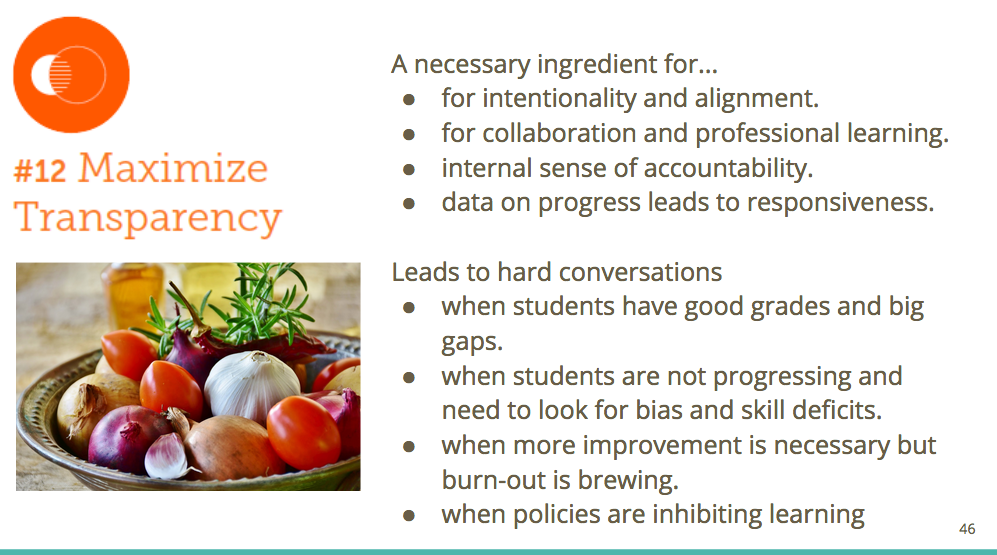
Transparency is as necessary an ingredient to CBE as onions, garlic and tomatoes are to Italian food. Transparent learning objectives help students to take ownership of their learning. Transparency about the overall district and school goals can enable staff to participate in distributed decision-making that balances both student well-being with overall goals. Transparency is important for creating intentionality and alignment. And for creating the open culture needed for collaboration and professional learning.
And transparency is a necessary ingredient for internal accountability. In the traditional education system, accountability was more about inputs than in terms of helping students learn. We simply assumed that some would learn, and others wouldn’t and that’s just the way of the world. In challenging the historical patterns of our education system we’ve also challenged that assumption …and there is an expectation of responsibliity. Of accountability. But CBE is about putting into place the pieces for an internal accountability system or continuous improvement. It’s about always seeking ways to improve and be more responsive to students.
Finally, transparency may lead to hard conversations. As we become honest about where students are in their learning progression there may be times when you’ll need to explain why students were getting good grades but aren’t reading at grade level. They are tough conversations but once through them there is a strong alignment of students, teachers and parents all working together to help students get back on the track to graduation.

The task for the next hour is to work with these four quality principles. For those of you just getting going you will want to work with the two short case studies. One is on EPIC North High School in NYC which was designed at the margins. They wanted to design so that African-American young men would be successful. The other is Waukesha STEM academy, a middle school outside of Milwaukee. They are both schools that are pushing the envelope in different ways.
As always, start by self-organizing. However, we will not be reporting out so you don’t need a story teller. And do take a 5-10 minutes for people to review the quality principles, case studies and work individually to gather their thoughts.
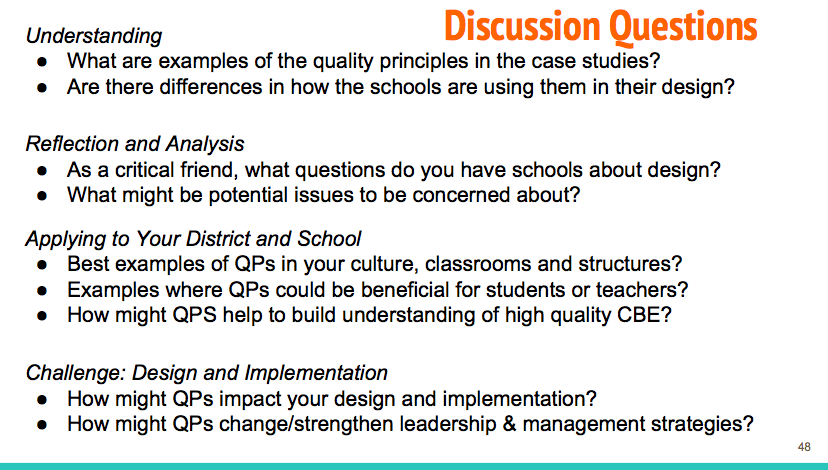
Do spend some time generating critical friend questions. For example, in Waukesha they are very transparent about where students are in terms of performance levels. I might ask them questions like:
- That’s great that everyone is working at their own level and pace but how do you keep that from falling into tracking?
- How do you handle it when students do know the standards but don’t have fluency?
You might think about how the traditional system might be influencing the implementation to generate critical friend questions.
For those districts with more experience in implementation you might want to warm up with the case studies …and move to the level of questions that feel right for you. You can always bring in other quality principles if you want to.
If there is time, we’ll wrap up with a group discussion.
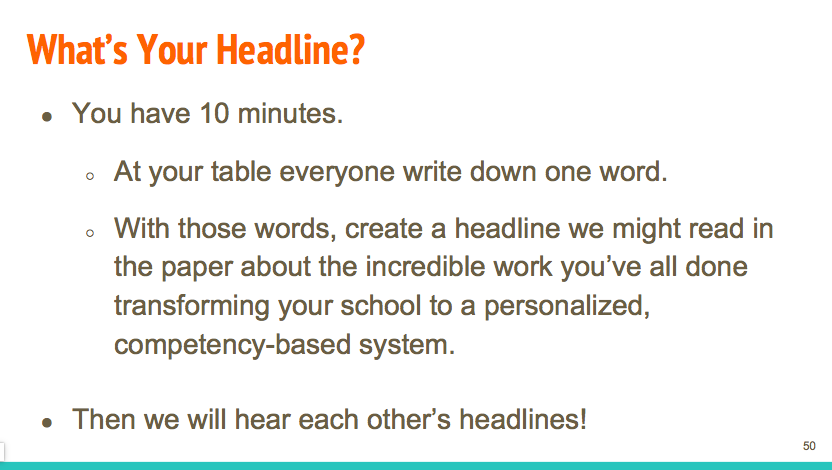
I know everyone’s brains are all filled up and you can’t process any more. But we have one more task to do and its a very fun exercise. You are going to create a newspaper headline about your district and each district will share theirs. But the trick is that you will create it by each person saying one word to create your headline. So…everyone write down one word…and you’ve got 5 minutes to create your headline.















